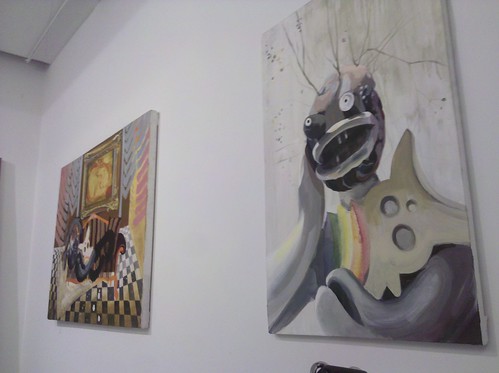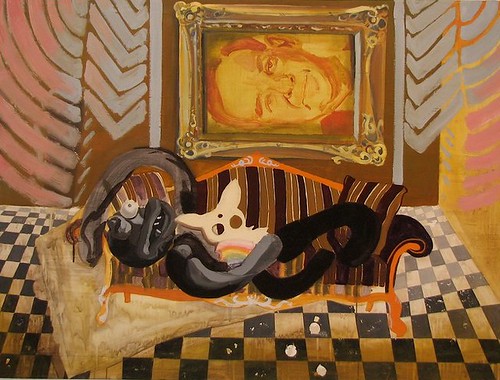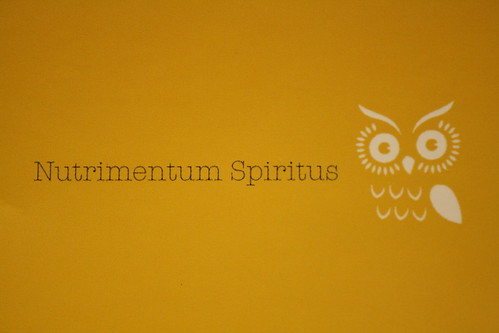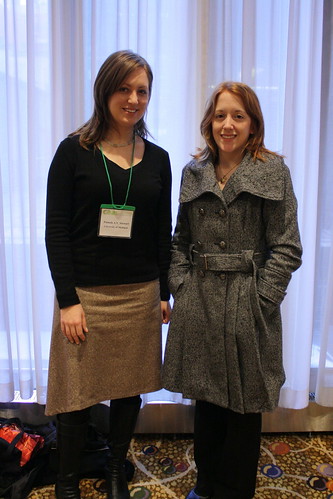Author Archives: Tempestt Hazel
Not Homesick Yet: Finding Chicago Art in New York
The CAA Conference offers many reasons to get excited. The amount of information and art combined with the excellent list of people presenting it–that alone is more than enough to bring out the geek in any art historian. Add the fact that the conference is held in one of the most culturally rich cities in the world and you’ll end up with a sensory explosion.
The task I have challenged myself to during my time in New York is not only to attend most of the sessions I am interested in, but also venture out to other places. I started yesterday during a late night studio visit with Columbia University MFA candidate, Chicago native and friend Caitlin Cherry. Sometimes it is nice to see the things on the opposite end of art history—the history in the making. For me, being at the Columbia University studios and then coming to the conference provides a balance between past, present and future.

In the Studio with Columbia University MFA Candidate Caitlin Cherry. February 8, 2011. (Image Credit: Tempestt Hazel)
What I love most about Cherry is that throughout her undergrad at the School of the Art Institute and now at Columbia University, she has stood firm for her love of painting. In an age of new media it takes a certain amount of courage to do that, in my opinion.

Reclining on Baroque Couch (Portrait of Mayor Richard M. Daley), 36 x 48 inches, acrylic gouache and oil on canvas, 2011. (Image: Courtesy of the artist)
At Cherry’s studio I got to see works in progress, including a very timely portrait of Mayor Richard M. Daley that she has been working on. In case you have not had a chance to catch up on your Chicago politics, the Windy City art community has been preparing for a big switch of administration from Chicago’s decades as a Daley-run city. The art community, which Daley’s reign has proved beneficial for in many ways, is doing what it can to let the incoming administration know that the arts are important in Chicago, and we will be heard. (See Mayoral Meet & Greet by Chicago Urban Arts Society or Arts Power Chicago).
The other places outside of the conference I plan on stopping at include the David Hammons show at L&M Arts, Dawoud Bey’s Harlem U.S.A. show at the Studio Museum in Harlem and the Ellen Gallagher show at Gagosian Gallery. See you there?
Bridging the Gaps: MFA Candidate Leighann K. Wood

Image on the back of Leighann K. Wood's business card. February 9, 2011. (Photo Credit: Tempestt Hazel)
We all know about the sessions of the CAA Conference through the conference program–but what about the people filling the seats of the sessions? Who are they? In an effort to answer this question, I randomly asked welcoming faces sprinkled around the CAA to answer a few simple questions about themselves, what brings them to the conference and why they chose to pursue art history and scholarship. I will be conducting several of these interviews at random throughout the weekend.
Leighann K. Wood, Graduate Student of Library and Information Science, Information and Arts Consultant, Denver Colorado, First year attending CAA Conference
Tempestt Hazel: What brings you to the CAA Conference?
Leighann K. Wood: I did my undergraduate in Art History at West Michigan University. Then I moved out to Denver and I just started my Masters of Library and Information Management program at Emporia State University. I’m basically trying to incorporate the art world within more text-based institutions, bring more of that visual bridge into libraries and connecting those multi-cultural communities that don’t have the access that they need. For instance, a lot of museums have educational programs for kids but they leave those adults out. So, I’m trying to work towards that.
TH: What sessions and events are you excited about?
LW: Actually anything technology-based. I resisted that during my [time as an] undergrad.
TH: When you say technology-based, what do you mean exactly?
LW: Technology-based meaning blogs or wiki—even art databases. Especially in the art community, they think they need to know how to use it efficiently and not resist it because it’s here to stay.
TH: Finally, why art history? What is it that you love about art?
LW: Everything. I’m a visual learner so I think that the most appealing thing [about it] to me is the community that it brings together. I really want to transpose that into my own life but also bring it into my own community.
In From Michigan: Ph.D. Candidates Katharine Raff & Pamela A.V. Stewart

University of Michigan Ph.D. Candidates Pamela A.V. Stewart & Katharine Raff at the CAA Conference. February 9, 2011. (Image Credit: Tempestt Hazel)
We all know about the sessions of the CAA Conference through the conference program–but what about the people filling the seats of the sessions? Who are they? In an effort to answer this question, I randomly asked welcoming faces sprinkled around the CAA to answer a few simple questions about themselves, what brings them to the conference and why they chose to pursue art history and scholarship. I will be conducting several of these interviews at random throughout the weekend.
Katharine Raff, Ph.D. Candidate in the Department of History of Art at University of Michigan and Fellow at Metropolitan Museum of Art, first year attending CAA Conference
Pamela A.V. Stewart, Ph.D. Candidate in the History of Art at University of Michigan, third year attending CAA Conference
Tempestt Hazel: What brings you to the CAA Conference and why do you think it is important to be here?
KR: For me, because I study ancient art there really aren’t as many sessions dealing with that, but my career path is to work in museums, so I’m here for more of the sessions dealing with issues concerning museums. And in general, what’s going on in the field at large. Sometimes you get so inside of your own discipline, it’s nice to know what else is going on with art and artists.
PS: [I came] for the exchange of ideas. There aren’t a lot of panels that are specifically in line with my interests but there are some fabulous papers that are coming up. It’s really good to keep up with what is going on in the field, who is giving papers, where their interests are and people who matter—having that dialogue and exchange.
TH: What sessions and events are you most excited about?
KR: The was the one this morning, Making Museums Matter, Art & Commerce: The Art Gallery In America—really dealing more with museums and with ancient Italian art. I’m excited to hear Lauren Hackworth Petersen for the Italian Art Society session [and her paper] Why Have There Been No Great Roman Artists? I really like her work and I’m excited to hear what she has to say.
PS: I saw the session [Are We Standing at a Digital Divide in Art Publishing?] this morning, which was pretty interesting. I’m about to go to—well, I’m split between Architecture, Space and Power in the Early Modern Ibero-American World and The Crisis in Art History. There’s also going to be a paper [presented] by one of my old mentors—Elizabeth ‘Buffy’ Easton. She is the most powerful curator in the world—that’s her superhero name that she gives herself. Buffy is all-powerful. [laughs]
TH: My final question is why art or why art history? What drew you to the field?
KR: Even as a child my parents always took me to museums and I started learning about things, why they were created, how they were used and how they function. A lot of what I do is social history oriented and there’s always been that wanting to know how things function and why—not just that it’s a painting on a wall. How was it really used? How did it function in its particular historical moment? I think that’s so important to understand. I think a lot of people, unless they study art history, they don’t always get that. They go to a museum and think, “Oh, that’s cool” but when they really start to study it they learn about the very complex background of what caused it to be created and how it functioned. So, that’s why [I chose] art history. I think it plays such an important role in the humanities. We need to push that.
PS: Art is how we see ourselves. This is the most basic kind of communication that we have. This is how we see the world, the image we construct of the world and the image we project onto the world. I think Michael Baxandall was right [when he spoke about] positing an artwork as a deposit of a social relationship—you can’t always get that from a text. An image is immediate, as Leonardo would say. That’s why painting is better than poetry! [laughs]
Notes From Seat 16A

Detail of Plane Ticket to 2011 CAA Conference. February 8, 2011. (Image Credit: Tempestt Hazel)
My flight was a little delayed. Even so, what has been on my mind while preparing for the CAA Conference has been mainly two things: 1.) What is there to learn from last year’s CAA Blog experience, and 2.) How can I clone myself between now and Laguardia so that I can make it to every session and every event of the conference that I want to go to?
While everyone was focused on the Super Bowl, I was focused on plotting out my strategy for the conference. Similarly, as the Packers and Steelers were making game plans, so was I. It looks like we art scholars have more in common with athletes after all.
Some of the panels I am having the most difficult time deciding between for Wednesday are the following:
- Nation Building: The Politics of Space in the African City
- The Aesthetics of Sonic Spaces
- Oral Histories and the Archive
- Gender and Sexuality in the Art Museum
- High Heels and Leather Masks: When Fetish Becomes Art and Art Becomes Life
- Recurating: New Practices in Exhibition Making
- Interdependent Identity: Paradigm and Paradox in Contemporary Israeli and Palestinian Art
…and that’s just the first day. So, how do you be everywhere at once? If you’re looking for me, I’ll be the one on the run.

